Saudi, Iranian FMs Hold Phone Call After Football Incident
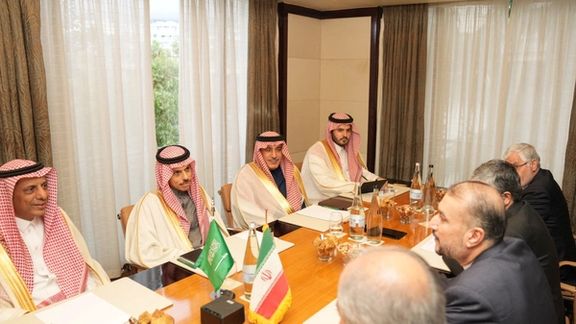
After a Saudi football team's refusal to play in Iran, Saudi Arabia's foreign minister has invited his Iranian counterpart to attend a game together in Saudi Arabia.

After a Saudi football team's refusal to play in Iran, Saudi Arabia's foreign minister has invited his Iranian counterpart to attend a game together in Saudi Arabia.
Media in Tehran reported on Friday that the two chief diplomats held a telephone call late on Thursday to discuss the incident in the Iranian city of Esfahan, when Saudi Arabia’s al-Ittihad football (soccer) team strongly objected to the presence of the former IRGC general Qassem Soleimani statue on the pitch and subsequently left Iran without playing the match.
Iranian government media also report that Faisal bin Farhan Al-Saud and Hossein Amir-Abdollahian discussed future cooperation plans, “with appropriate political relations.” Bin Farhan called for continuing football matches, which he said were important to strengthen ties, and invited Amir-Abdollahian to Saudi Arabia to watch a match together.
The two foreign minister recently met in New York on the sidelines of the annual UN General Assembly.
Soleimani, who was Iran’s chief military and intelligence operative in the Middle East before being killed by a US drone strike in 2020, is seen by many regional countries as a figure who organized militant militias throughout the Middle East. These groups have been instruments of Iran’s influence and some are designated as terrorist that have fueled conflicts in the Levant, Iraq and in Yemen.
Iran re-established relations with Saudi Arabia in March after seven years of bitter adversarial relations. The Iranian Shiite clerical rulers have for many years used derogatory rhetoric and threatening language against the Saudi ruling family, who are seen as influential leaders among regional Arab Sunni countries.
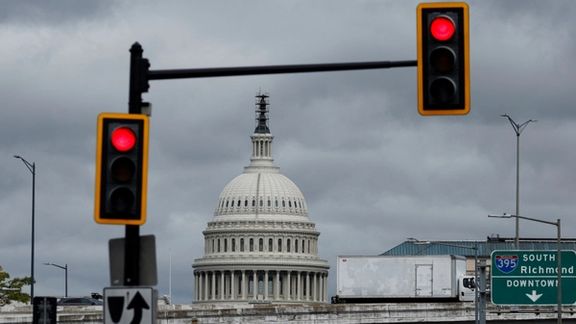
During a March 25, 2020, cabinet meeting, President Hassan Rouhani revealed Tehran's propaganda efforts to alter public opinion on sanctions against the Islamic Republic.
Iran International revealed recently the existence of a network which was promoting Iran’s policies on the global stage. These influence campaigns, which could be ultimately the same, might have reached and influenced US lawmakers and members of the US administration, including Robert Malley, who later became the US envoy for Iran.
Rouhani bragged to his top lieutenants “Our Foreign Ministry has launched a concerted effort to influence public opinion and to say ‘no’ to sanctions. Our efforts are geared at bringing back our money seized in other countries.” This campaign has been highly successful in recent months as the United States unfroze between $6 billion and $16 billion in Iranian funds that had been locked in South Korea and Iraq, claiming the funds would be used for food, medicine, and other humanitarian goods.
The need for the Iranian government’s campaign had started a year earlier when US oil sanctions had started shrinking the Iranian regime's ability to fund terror abroad. The New York Times quoted one Iranian-backed fighter in Syria saying"the golden days are gone and will never return," because "Iran doesn't have enough money to give us."
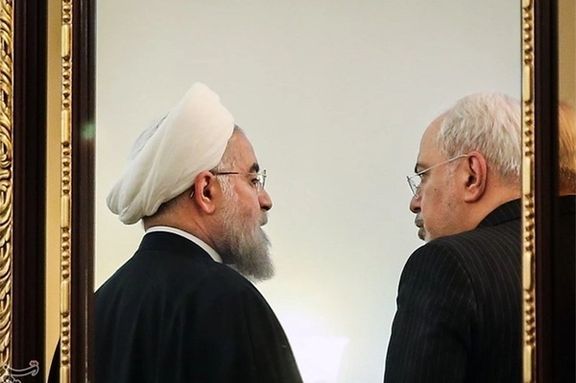
This caused a panic in the Iranian regime, and the Foreign Ministry was tasked with pushing back against US sanctions. Led by Foreign Minister Javad Zarif, they developed and deployed two main public narratives: first, that sanctions didn't hurt the regime and would never bring it to the negotiating table, and then a second narrative: that sanctions only hurteveryday Iranians and prevented their access to medicine.
The emergence of COVID provided a powerful opportunity to reinforce this narrative - particularly around a claim that sanctions were blocking Iran from responding to the pandemic.
Iran was the first country after China to be inundated by the virus. The reason was politics: the regime pretended COVID didn't exist to protect its relationship with the Chinese Communist Party. While other airlines were halting all flights in and out of China, Iranian airline Mahan Air operated at least 55 flights between Tehran and China in February 2020.
The regime only admitted COVID had even entered Iran nine days after the first death, and then – like China, the regime firmly cracked down on all information about the virus that could have saved lives. On March 5, the head of Iran’s cyber police announced the arrest of 121 Iranians for “spreading rumors” about the coronavirus. The regime threatened medical staff against revealing accurate statistics of coronavirus cases and deaths.
The State Department was concerned that the unchecked spread of COVID inside Iran could further supercharge the virus, causing untold deaths in the country, the region, and beyond. On February 28, 2020, Secretary Pompeo confirmed the State Department had sent a diplomatic message to Iran offering medical aid. The regime rejected the offer within hours.
A month later the regime kicked out Doctors Without Borders, accusing their staff of being spies. But even while the regime rejected medical assistance from America and Europe, their propagandists claimed to Western audiences that US sanctions blocked Iran from getting help.
In early March 2020, the Foreign Ministry launched a propaganda clearinghouse called Corona2Plus. The site was a central repository and coordination center for Iran's "diplomats" and influencers around the world. While the site has since been erased from the internet before being archived, it featured ready-made graphics and talking points like one used by the Iranian Embassy in Norway which compared US President Donald Trump to the coronavirus, claiming that both killed Iranian people.
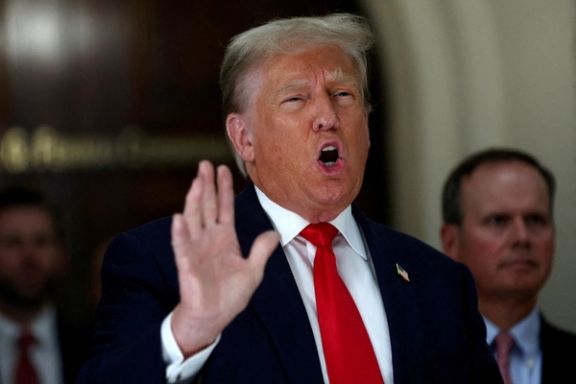
These messages directed European and Western audiences to sign a petition on the propaganda site to “lift sanctions on Iran”. Iranian ambassadors were tasked with writing and distributing op-eds, particularly to Western audiences, designed to blame America for Iranian COVID deaths. One such letter, published in The Irish Times by Iran’s Ambassador to Ireland, claimed that sanctions were “denying Iranian people access to medical supplies and equipment.”
Not only do US sanctions have clear exemptions that allow humanitarian and medical trade with Iran, but the regime’s own Health Minister Saeed Namaki was simultaneously saying he had no problem obtaining all the necessary medicine and equipment. In late March 2020, Namaki admitted that Iran “has not faced a shortage of special drugs needed to treat this disease,” and that Iran had a seven-month stockpile of medicine.
Although the Iranian government was mishandling the response to the virus, the regime’s supporters focused their efforts pushing the blame onto US sanctions. This messages rapidly made their way into Western media, including through a March 17, 2020 opinion piece in Foreign Affairs by Robert Malley and Ali Vaez that stated the regime’s response to COVID “was hampered by shortages caused by sanctions… the government is now pleading for international assistance.”
The authors cited as evidence a tweet by Foreign Minister Zarif supposedly listing desired medical equipment, then proceeded to argue the United States should permit an IMF loan to Iran “providing Tehran with some economic reprieve and the means to save lives at home.” Their piece was further amplified by a New York Times opinion piece that repeated even more Iranian talking points. The rapid rhetorical pivot from requesting COVID relief to suggesting financial relief was typical of regime messaging.
It is true the Iranian Ministry of Health lacked adequate funding to rapidly respond to the crisis. In January 2019, the Deputy Health Minister Hassan Hashemi even resigned in protest of budget cuts. But the government had no shortage of funds at this time they could have used to provide this funding. In 2018, Iran withdrew $2.5 billion from its National Development Fund for increased defense spending, and a further $1.5 billion in 2019 for other military expenses.
The regime’s priorities have always been transparent through its budgetary decisions. On March 9, 2020, five Iranian parliamentarians begged Supreme Leader Khamenei to transfer assets from his $30-100 billion hedge fund for the COVID response. President Rouhani eventually wrote to the Supreme Leader requesting permission to withdraw $1 billion from the National Development Fund for that purpose. Before Khamenei responded to the urgent request, he intervened in the budgetary process to increase the IRGC's budget by 33% and doubled funding for the Basij brute squads.
Khamenei eventually approved allocation of one billion euros in foreign exchange reserves for the Health Ministry. But the majority of the funds never arrived. In September 2020, the Health Minister complained he had only received 27% of the promised funds, noting that healthcare workers were going unpaid. The chairman of the Parliament’s Health Committee Hossein Ali Shahriari charged that: “A billion dollars has been withdrawn from the fund but has been spent somewhere else.”
As the Iranian regime’s propaganda crescendoed in March 2020, some Members of Congress started retweeting content that came from Corona2Plus and calling for US sanctions on Iran to be lifted in order to save Iranian lives. Stories about these tweets were then posted on the Iranian propaganda center for further amplification. As the Corona2Plus site has since been erased from the internet, it is no longer possible to provide documentation of this particular development.
However, in late March 2020, 34 Senators and Representatives sent a letter to the State Department and Treasury Department calling for the suspension of oil sanctions to aid Iran's health response. However, anyone familiar with Iran’s budgetary process knows that oil revenue is funneled directly to the IRGC and Iran’s military, not to the Iranian people.
At that time, even some career officials in the State Department, where I worked at the time as the Special Advisor for Iran, were worried that these members of Congress - and the organizations that had endorsed the letter - had been influenced by the information environment fastidiously created by the Iranian Foreign Ministry.
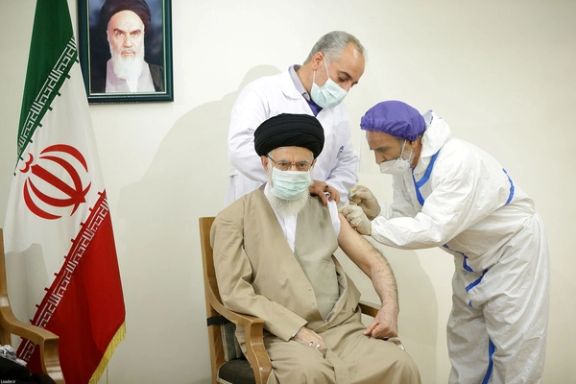
The State Department sent a detailed response to these members outlining the facts about Iran's COVID mismanagement and how the United States had designed policies to help the Iranian people. Yet the propaganda advanced by Iran’s Foreign Ministry has persisted in messaging used to critique US sanctions on Iran.
A common theme echoed by many supporters of engagement with the Iranian government was that the United States should prioritize giving COVID vaccines to Iran – even before sending to US allies. This line of messaging was undercut when Supreme Leader Khamenei announced on January 8, 2021, a ban on the import of American and British vaccines. Medical experts estimated this ban resulted in the excess death of between 50,000-75,000 Iranians.
The sad reality is that time and again the regime does not hesitate to sacrifice the wellbeing of the Iranian people in order to advance its ideological aims and agendas. For years the regime has reallocated funding away from food, medicine, and medical equipment to fund its violent revolutionary ambitions. Then the regime and its supporters claim that Iran needs sanctions relief so the government can provide for the Iranian people.
Over the previous few months, the Iranian government achieved their aims set out by President Rouhani: the return of between $6-16 billion in Iranian assets held abroad. Unfortunately, the U.S. government continues to play in Iran’s own information environment, claiming the funds would be used for food, medicine, and humanitarian goods, despite ample evidence of abuse of these goods by the Iranian regime.
The past serves as a prelude, and we should not be surprised when the regime redirects the latest infusion of unfrozen cash. As that happens, Western governments should carefully document the abuse of funds and watch who will once again rise to the regime’s defense.
Opinions expressed by the author are not necessarily the views of Iran International.
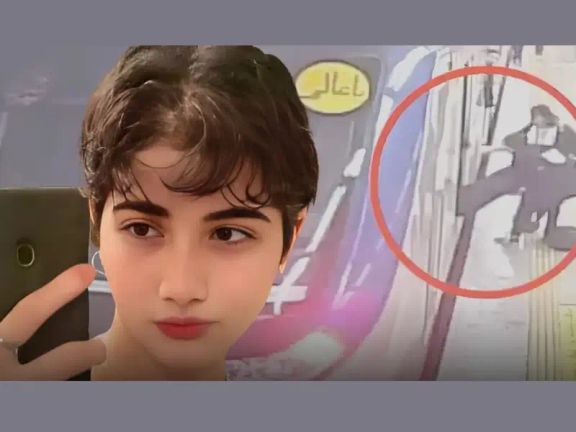
Iran's state television has again accused opposition media of spreading false information about a girl falling into a coma after an alleged assault by hijab enforcers.
In its Thursday evening news bulletin, IRIB’s News Channel aired footage released on Wednesday showing Armita Geravand entering a Tehran subway station without covering her hair, waiting with friends, and then being carried out of a metro car unconscious by her friends after collapsing seconds after entering.
State media claims the sixteen-year-old art student fainted, fell, and hit her head on the metro car's entrance. Armita's mother, Shahin Ahmadi, stated in an interview with IRIB that she was "told" her daughter hit her head "on the edge of the metro [car or platform]." Earlier reports suggested she was pushed by a hijab enforcer inside the metro car, causing her fall and head injury.
Hengaw Organization for Human Rights, a Kurdish rights group that published the comatose Armita’s photo at Fajr hospital’s intensive care unit Wednesday, claimed on Thursday that security forces have detained Armita’s mother. Mizan Online, the news agency of Iran’s Judiciary, denied the report shortly after its release.
Security is tense around the hospital, and authorities are not forthcoming about the circumstances surrounding Armita's coma. Meanwhile, the media is filled with concerns from Iranians, foreign activists, and officials, all fearing a scenario similar to Mahsa Amini's death could reoccur.
Iranians have been extensively posting to raise awareness about Armita, making the hashtag of her name in Persian trendy on X (formerly Twitter) with well over 300,000 retweets.
Despite the IRIB's account and interviews with Armita's parents and friends, many in the public remain unconvinced. Social media users believe that state media is concealing the true cause of her head injury to prevent public anger, similar to the 2022 protests following the death of Mahsa Amini in morality police custody.
The state media have not shown any footage from inside the metro car and claim there were no CCTVs to record the incident inside the train.
Two eyewitnesses have, however, confirmed to the Guardian that hijab enforcers were involved in Armita’s injury Sunday morning.
One of the two eyewitnesses has told the Guardian that soon after Armita entered the carriage, a female hijab enforcer started arguing with her because she wasn’t wearing a headscarf. “The chador-clad woman screamed at her asking her why she was not covered,” the witness told the Guardian.
“Armita then told her ‘Do I ask you to remove your hijab? Why are you asking me to wear one?’ Their argument then turned violent. The hijab enforcer started physically attacking Armita and … violently pushed her.”
Another witness told the Guardian that the young girl was still conscious when she fell on the ground. In the video footage shown on state television Armita’s leg appears to be moving.
Witnesses who spoke to the Guardian also claimed they spotted the same hijab enforcer waiting behind the ambulance that took her to the hospital.
Iranian activists and social media users argue that security forces' efforts to restrict access to the hospital, detain a reporter who attempted to interview Armita's mother, and suppress independent media suggest they are trying to conceal the truth about the alleged assault on the young girl.
The interviews with Armita's family were aired during the 8:30 news program on Wednesday. The program's producer, Ameneh Sadat Zabihpour, has faced allegations of collaborating with intelligence organizations to obtain forced "confessions" from activists and others, discrediting them, opposition figures, and groups. Zabihpour and her colleague Ali Rezvani were sanctioned by the United States Treasury in November last year for their involvement in obtaining forced confessions.

Russian President Vladimir Putin has expressed a strong desire for closer ties with Iran,announcing plans to establish Russian schools to cater to Iranian students.
“We are making every effort to further develop our relations with Iran, and we will continue to do so in the future," Putin stated during an event held on Wednesday night in the resort city of Sochi.
He was addressing the winners and finalists of a competition to select the best teacher in Russia, as reported by Russia's Sputnik news agency.
Putin also discussed the possibility of establishing educational institutions in Iran as part of a broader effort to strengthen ties between the two nations.
The Russian president also emphasized the importance of "soft power" in improving Iran-Russia relations, describing it as a means of promoting culture and education. He stated, “Soft power in the kindest and best sense of this word, the promotion of our culture and our education systems. We will mull this over as well,” according to Russia's TASS media.
The comments are part of a larger set of statements from Putin about the necessity of a multipolar world that is more democratic. Interestingly, he was discussing the need for authoritarian regimes like Russia to challenge the US-led democratic world order. From Moscow's perspective, the world is currently under the "dictatorship" of a US-led model that drives nations into debt, creates economic dependencies, and deprives certain regions of resources for development.
Nations such as Iran, Russia, and China are actively pursuing strategies to reduce their reliance on Western influence and the predominance of the US dollar, aiming to shield themselves from sanctions and Western institutional pressures
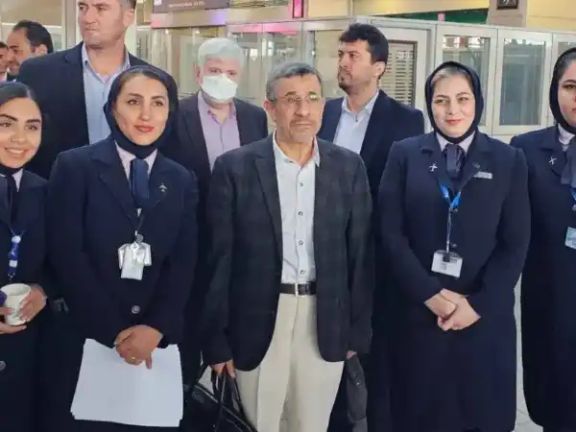
Security authorities at Imam Khomeini Airport in Iran thwarted former President Mahmoud Ahmadinejad's trip to Guatemala, seizing his passport and giving him a travel ban.
Stopped by IRGC intelligence officers, Ahmadinejad was traveling to a scientific and research symposium on water resource management, as a guest of the government and the University of Guatemala.
There has long been talk of a travel ban on Ahmadinejad, however, even before the latest designation. Back in 2021, rumors began of the ban being lifted when he took a trip to Dubai, visiting the Dubai Expo. The trip was cut short by Tehran after the former president began making statements claiming to be the voice of the Iranian people, a press conference in the UAE's party capital being canceled for fear of his gaining political capital and Ahmadinejad swiftly brought back to Iran.
However, the rumors may now be true, the former president designated by the US Department of the Treasury last month, facing allegations concerning the fate of Robert Levinson, a US national who vanished in 2006 after flying from Dubai to Iran's Kish Island. Despite no conclusive information regarding his whereabouts, the US government believes he may have died while in Iranian custody.
Ahmadinejad served as the President of Iran from 2005 to 2013. The DOT claims "During Ahmadinejad’s term in office, MOIS [Ministry of Intelligence and Security] was involved in the detention of several US nationals, including former Federal Bureau of Investigations (FBI) special agent Robert “Bob” Levinson, as well as three US hikers: Shane Bauer, Joshua Fattal, and Sarah Shourd."
However, media outlets tied to the Islamic Republic have reported that it is "Guatemala's fragile political climate" and "security concerns" which led to the stoppage, Ahmadinejad a member of the Expediency Council and an official political figure. "He has been strongly advised against undertaking the journey, taking into account international sanctions and the risk of detention," Khabar Online claimed.
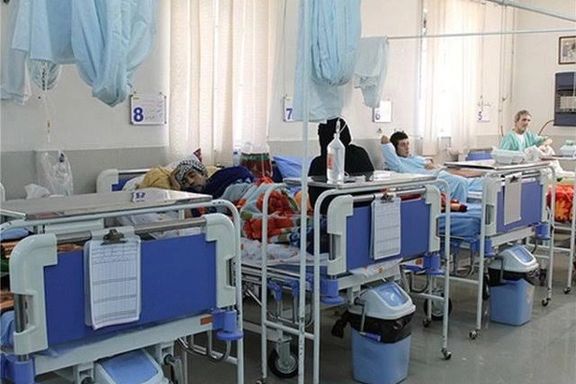
There has been a spike in patients fleeing healthcare facilities in Iran due to the high cost of medical treatment, with some hospitals resorting to imprisoning patients.
In a report published by the Ham-Mihan newspaper on Thursday, a head nurse at a government hospital in Tehran disclosed that, on average, two to three patients per week flee without settling their medical bills. Such occurrences frequently involve patients from the emergency department, including injured construction workers and working class Iranians.
It is not only Iranians mixed up in the scandal, with several patients lacking medical coverage, migrants who lack insurance coverage, unable to pay the higher fees for those not covered. Rising costs of living, shortages of medication, expensive laboratory tests, and hospitalization fees are all compounding the problem.
Some families are even unable to claim dead bodies due to high hospital bills. One such case involved a young Afghan laborer who underwent heart surgery at a Tehran government hospital but did not survive. The hospital issued a $2,000 bill for his friends, who were unable to pay, leading them to abandon his body at the hospital.
In such cases, bodies typically remain in the morgue for several days, and if relatives do not claim them, they are buried anonymously, labeled as "unidentified."
In another section of the report, Mohammad Sharifi Moghadam, the Secretary-General of the Nursing House, mentioned that a large hospital in Tehran has established separate rooms for impoverished patients and keeps them in custody until their medical expenses are settled.